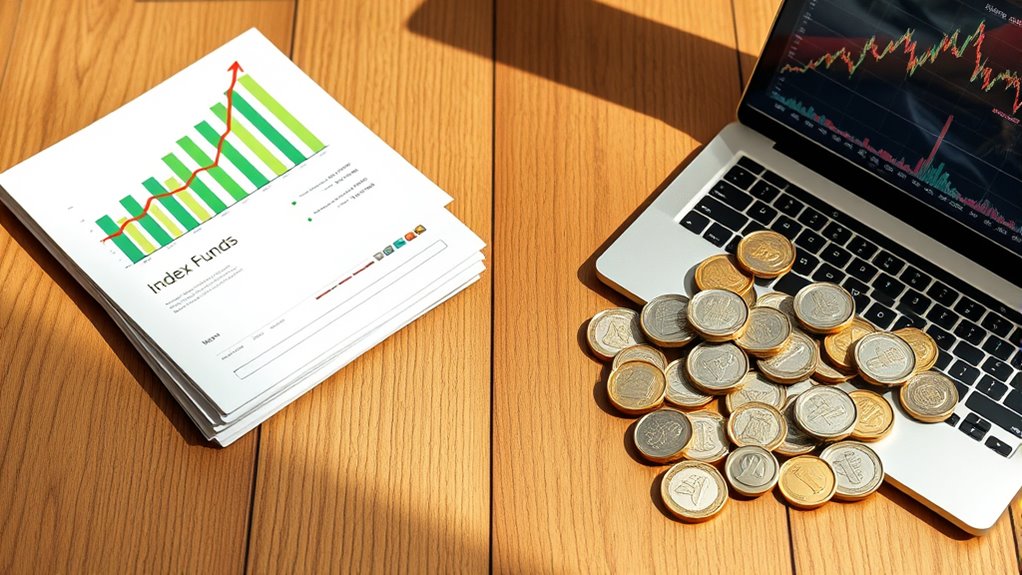Index funds and ETFs both offer low-cost ways to invest in diversified portfolios, but they differ in trading and dividend reinvestment. Index funds are bought and sold at end-of-day prices and usually support automatic reinvestment, making them more passive. ETFs trade throughout the day at market prices and often require manual reinvestment, giving you more flexibility but adding extra steps. To understand which suits your investing style, explore the details further.
Key Takeaways
- Index funds are bought and sold at end-of-day NAV, while ETFs trade throughout the day at market prices.
- ETFs typically have lower expense ratios and offer intraday trading flexibility.
- Index funds often include automatic dividend reinvestment, making wealth compounding easier.
- ETFs require manual reinvestment through brokerage accounts, possibly incurring additional steps or fees.
- Choice depends on whether you prefer passive, set-it-and-forget-it investing or active trading flexibility.

Are you trying to decide between index funds and ETFs for your investment portfolio? Both options can be effective for building wealth over time, but understanding their key differences can help you choose the right fit. One important factor to consider is how each handles dividend reinvestment. With index funds, dividend reinvestment is typically automatic if you set up a dividend reinvestment plan (DRIP). This allows your dividends to be used to buy more shares of the fund without any extra effort on your part. ETFs, on the other hand, usually require you to manually reinvest dividends through your brokerage account, which might involve additional steps or fees. This difference can influence how seamlessly your earnings compound over time.
Another vital aspect to weigh is expense ratios. Both index funds and ETFs are known for their low costs compared to actively managed funds, but there are notable differences. Index funds often have slightly higher expense ratios due to management fees and administrative costs, though they remain relatively inexpensive. ETFs tend to have lower expense ratios because they are traded like stocks and have fewer administrative expenses. Over the long term, even small differences in expense ratios can considerably impact your returns, so it’s worth comparing these costs carefully before investing.
Liquidity and trading flexibility are also important considerations. ETFs are traded throughout the day on stock exchanges, meaning you can buy or sell shares at market prices whenever the market is open. This gives you more control and the ability to react quickly to market changes. Index funds, however, are bought and sold at the end of the trading day at their net asset value (NAV). If you prefer the flexibility of intraday trading or want to take advantage of real-time pricing, ETFs are generally more suitable. Conversely, if you prefer a straightforward, set-it-and-forget-it approach, index funds can simplify the process with automatic investments and redemptions.
Frequently Asked Questions
How Do Taxes Differ Between Index Funds and ETFS?
You’ll find ETFs generally more tax-efficient than index funds because they typically generate fewer capital gains. When you sell, ETFs often allow for in-kind transfers, reducing taxable events. Index funds might distribute capital gains more frequently, leading to higher taxes. So, if tax efficiency matters, ETFs could be a better choice, as they help you keep more of your investment growth by minimizing taxable capital gains.
Which Investment Offers Better Diversification Benefits?
Think of your portfolio as a garden; diversification is your soil’s richness. Index funds often offer broader sector focus, spreading your seeds across many areas, which means better diversification benefits. ETFs, with their targeted investment strategies, can be more specialized, but sometimes leave gaps. So, if you want a lush, diverse landscape, index funds tend to be your best bet for spreading risk and cultivating growth across sectors.
Are There Specific Scenarios When One Is Clearly Preferable?
You’ll prefer ETFs when you need greater trading flexibility and tax efficiency, especially if you want to buy or sell throughout the day. On the other hand, if you seek a straightforward, low-cost investment and are less concerned about trading timing, index funds might be better. Consider your investment horizon and tax situation to decide which option aligns best with your goals.
How Do Fees and Expense Ratios Compare?
Think of fees and expense ratios as the fuel powering your investment journey. ETFs usually offer lower expense ratios, making them more tax-efficient and providing greater trading flexibility—like a sleek, agile vehicle. Index funds might have slightly higher fees, but they often come with automatic investment features. Your choice depends on whether you value cost savings and flexibility or prefer the steady, hands-off approach.
Can Both Be Purchased Through Retirement Accounts?
Yes, you can purchase both index funds and ETFs through retirement accounts. When considering rollover strategies, you might transfer assets into a tax-advantaged account that aligns with your goals. Both offer flexibility for asset allocation, helping you diversify your portfolio. Keep in mind, ETFs can be bought and sold like stocks, while index funds are typically purchased at the end-of-day net asset value, influencing your investment timing and strategy.
Conclusion
Think of index funds and ETFs as different routes to the same destination—building wealth. Just like choosing between a scenic highway or a direct flight, both get you there, but your preference depends on your style. For example, I once thought I’d prefer the quick, flexible ETF, only to find that index funds offered a more straightforward ride. Whichever path you pick, remember that consistency and knowledge are your best co-pilots on this financial journey.









